Birdfinding.info ⇒ Declining and now uncommon and localized on Java and Bali, but numerous and increasing in peninsular Malaysia. Easy to find in city parks of Singapore and Kuala Lumpur. In Taiwan, it is generally numerous throughout the coastal lowlands, including Taipei, Hualien, Taichung, Tainan, and Kaohsiung.
Javan Myna
Acridotheres javanicus
Native to Java and Bali; introduced to the Malay Peninsula, Borneo, and Taiwan. Mainly in humid open and semiopen habitats, including cities and agricultural areas.
Has declined dramatically in its natural range, such that IUCN designated it as vulnerable in 2016, having estimated its native population at less than 10,000. Introduced populations now greatly exceed that.
Widespread in peninsular Malaysia from Singapore north to southernmost Thailand. In Singapore alone, the population was estimated at 168,000 in 2000.
Smaller populations exist on Taiwan (estimated as >20,000 in 1999), on Borneo in southern Sarawak and Sabah, and reportedly on Sumatra as well.
Identification
A medium-large, gray-and-black myna with a short bushy frontal crest, mostly-white undertail, and white wing-patches across the bases of the primaries.
The bill and legs are bright yellowish-orange, and the eyes are pale-yellow, sometimes whitish or bluish-white.
Viewed from above, the tail is black with a white border on the sides and tip.

Javan Myna. (Along road from Batang Kali to Genting Highlands, Malaysia; March 20, 2012.) © Amar-Singh HSS
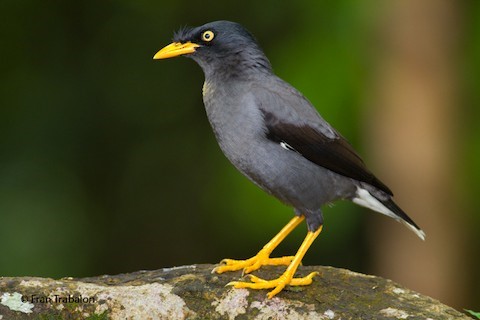
Javan Myna. (Bukit Timah, Singapore; November 15, 2011.) © Fran Trabalon
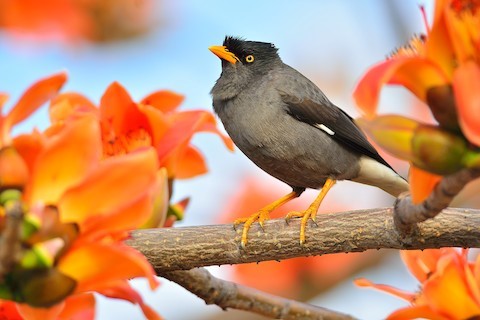
Javan Myna, posing in a floral arrangement. (Taichung City, Taiwan; February 17, 2019.) © Wbird Tsai

Javan Myna, showing white undertail. (Shek Kong, Taiwan; February 24, 2013.) © Cherry Wong
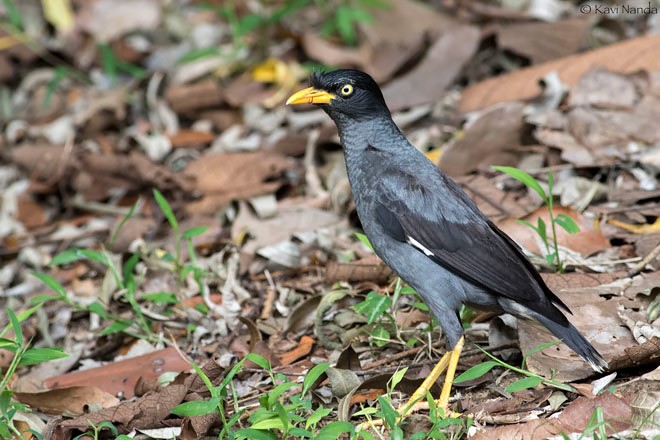
Javan Myna, showing contrast between black head and wings and gray body. (Singapore Botanic Gardens, Singapore; August 9, 2016.) © Kavi Nanda
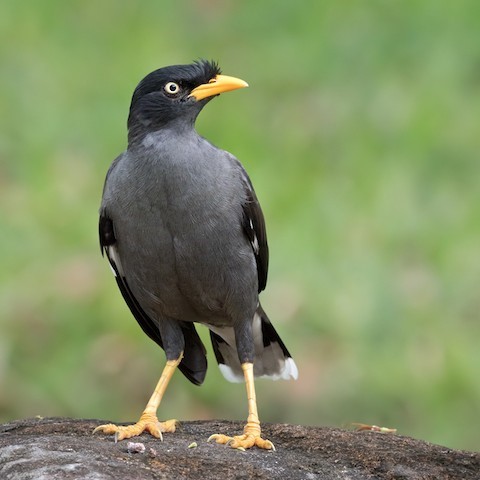
Javan Myna, ventral view. (Bishan-Ang Mo Kio Park, Singapore; April 12, 2019.) © Lars Petersson
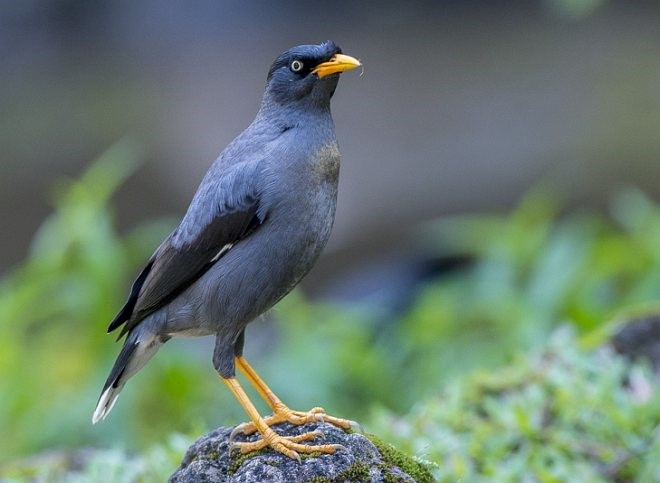
Javan Myna. ( Taman Safari, Bogor Province, Java, Indonesia; April 29, 2018.) © Vijay Anand Ismavel

Javan Myna, showing generally dark-gray-to-black plumage. (Singapore; May 23, 2005.) © Lip Kee Yap
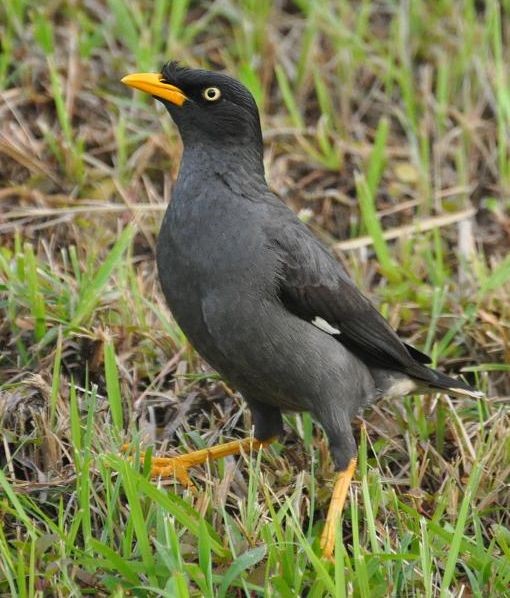
Javan Myna. (Singapore; January 19, 2011.) © Srimonti Dutta

Javan Myna, showing blackish head and wings contrasting with grayer body. (Bangsar, Kuala Lumpur, Malaysia; February 26, 2011.) © Pathmanath Samaraweera
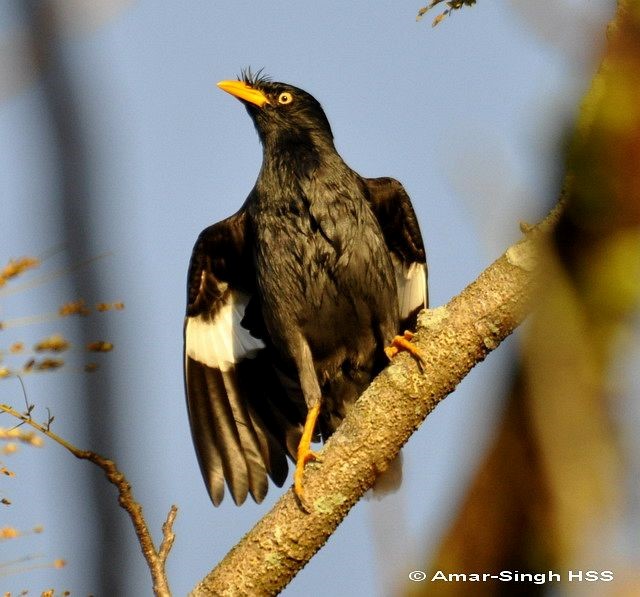
Javan Myna, with wings partly open, showing shape and position of white wing-patches. (Kuching Waterfront, Sarawak, Borneo, Malaysia; September 27, 2010.) © Amar-Singh HSS
Immatures generally resemble adults but are browner, especially on the head and wings.
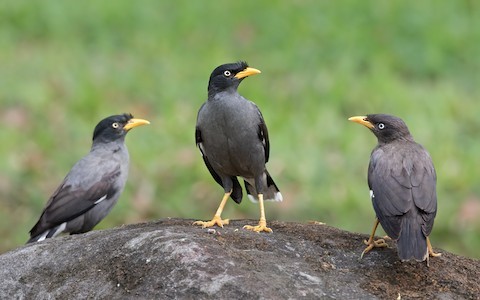
Javan Myna, two adults and an immature (at right). (Bishan-Ang Mo Kio Park, Singapore; April 12, 2019.) © Lars Petersson
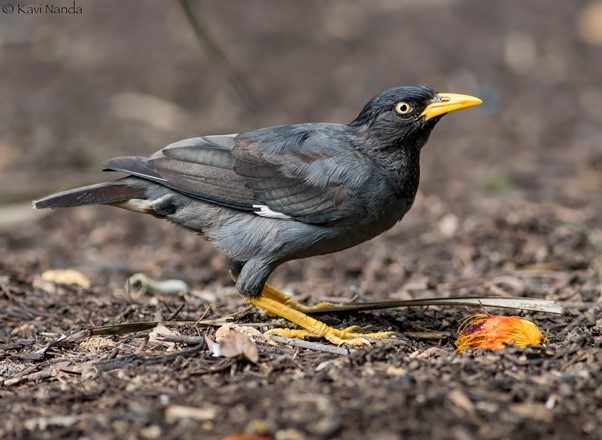
Javan Myna, likely an immature, showing partly brownish plumage and no discernible crest. (Singapore Botanic Gardens, Singapore; August 9, 2016.) © Kavi Nanda
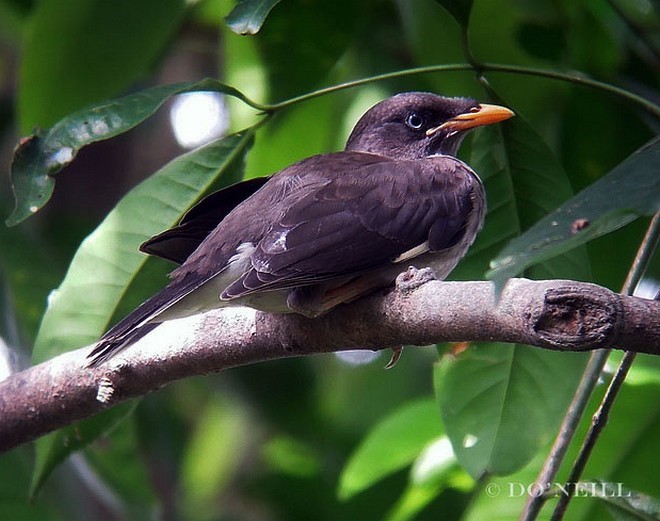
Javan Myna, immature. (Sungai Dua, Butterworth, South Perai, Malaysia; September 21, 2014.) © Daisy O’Neill
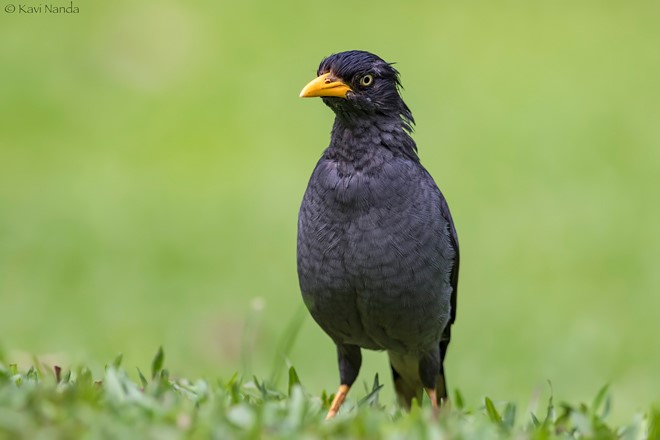
Javan Myna. (Singapore Botanic Gardens, Singapore; August 9, 2016.) © Kavi Nanda
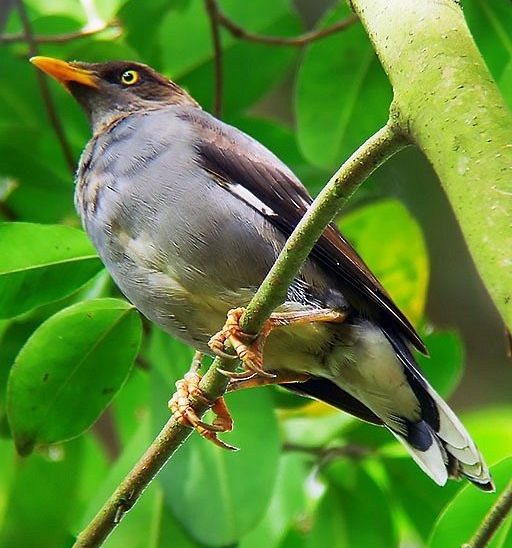
Javan Myna, apparently an immature moulting into adult plumage. (Sungai Dua, Butterworth, South Perai, Malaysia; September 21, 2014.) © Daisy O’Neill

Javan Myna, immature. (Ipoh, Perak, Malaysia; February 10, 2018.) © Amar-Singh HSS
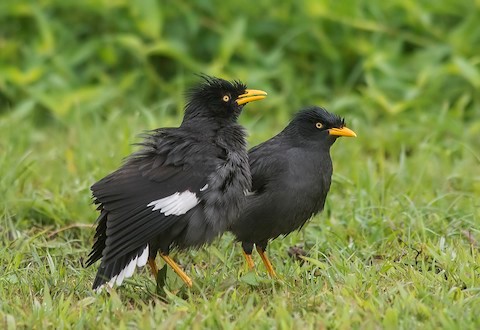
Javan Myna, spreading wings and tail, showing black-and-white pattern on both. (Yangguang Sports Park, Taipei, Taiwan; February 6, 2018.) © Jerry Ting

Javan Myna, in flight, showing shape and position of white wing-patches. (Kuala Lumpur, Selangor, Malaysia; June 10, 2013.) © Tomas Grim
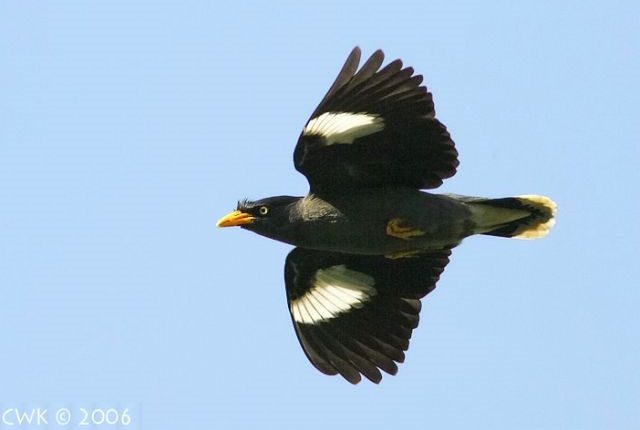
Javan Myna, in flight, showing shape and position of white wing-patches. (Singapore; 2006.) © Jonathan Cheah Weng Kwong

Javan Myna, landing and showing white tail-band and wing-patches. (Nilai, Negeri Sembilan, Malaysia; October 5, 2011.) © Amar-Singh HSS
Voice. Song is an apparently random assortment of whistled or buzzy notes and phrases delivered at a leisurely pace: Bukit Batok, Singapore; July 4, 2011, © Pamela C. Rasmussen
Cf. Other Bushy-Crested Acridotheres Mynas. Javan is one of six Acridotheres mynas that have bushy frontal crests, gray-to-black plumage, and white wing-patches. Four of these are widespread and have partially overlapping ranges, due largely to introductions: Great (grandis); Crested (cristatellus); Javan (javanicus); and Jungle (fuscus). As a result, they are readily mistaken for one another.
The other two species are more localized and distinctive: Pale-bellied (cinereus) is an endangered endemic of Sulawesi; and Collared (albocinctus) is nearly endemic to Myanmar but occurs in bordering areas of India and China.
Among the four widespread bushy-crested mynas, Javan is probably the most universally confusable. It is closest to Great in bill and leg color and undertail pattern; intermediate between Crested and Jungle in general coloration and crest size; and has the same eye color as Jungle. Its distribution adds to the potential confusion, as it has been nearly extirpated from its natural range, but has become common in the natural ranges of other species. In many reference works, Javan and Great Mynas have shared the name White-vented Myna, adding yet another layer of potential confusion.

Mixed flock of bushy-crested Acridotheres mynas: six Great, four Collared, and one Crested (the second from the right). (Yingjiang, Yunnan, China; December 31, 2018.) © Steve Bale
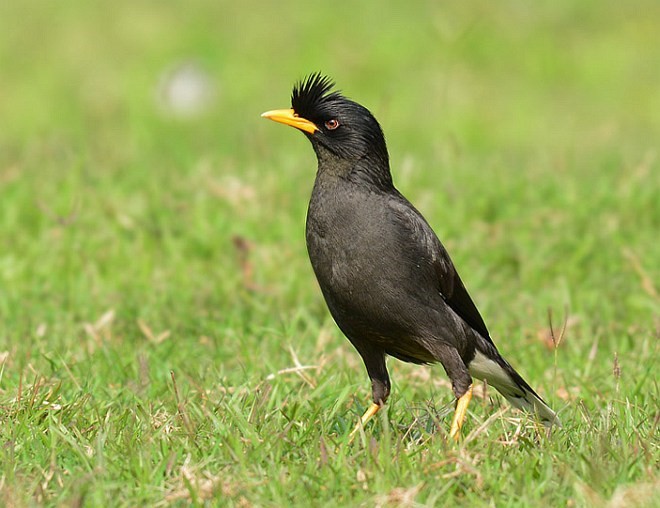
Great Myna. (Tinsukia, Assam, India; March 6, 2016.) © Mayuresh Khatavkar

Crested Myna. (Penang Botanical Gardens, Pulau Pinang, Malaysia; January 14, 2019.) © Neoh Hor Kee

Javan Myna. (Bukit Timah, Singapore; November 15, 2011.) © Fran Trabalon
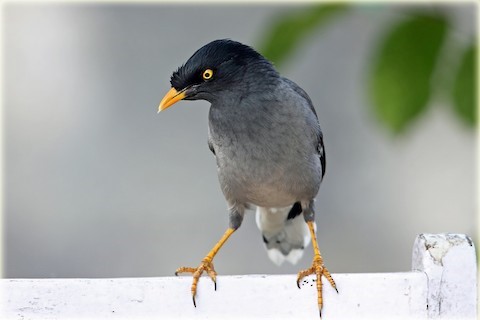
Jungle Myna. (Kathmandu, Nepal; October 7, 2014.) © John Thompson
Overall Coloration: The base color of the body plumage differs somewhat, but also varies within species. Typically: Great is close to jet-black; Crested tends to show some gray tones; Javan is dark slaty-gray with a blacker hood; and Jungle is medium slaty-gray with some brown tones and a more contrastingly black hood.
Tail and Vent Color: Great, Javan, and Jungle all have mostly white undertail coverts and extensively white tail feathers, whereas Crested’s undertail coverts and tail feathers are narrowly tipped with white. Great typically appears jet-black overall, so its white undertail contrasts more sharply than the others’.
Eye Color: Although eye color is somewhat variable and lighting-dependent, and therefore not always reliable, it can be helpful for confirmation. Great’s eyes usually appear dark-brown, or reddish when illuminated. Javan and Jungle usually show pale-yellow or whitish or sometimes bluish-white eyes. Crested’s eyes are consistently medium-orange, paler than Great’s and darker than Javan and Jungle’s.
Bill and Leg Color: Great, Javan, and Jungle Mynas all have roughly matching yellowish-orange bills and legs—although Jungle differs in that its bill is strongly bicolored, with a black base. Crested’s bill is pale greenish-yellow (or ivory or “horn-colored”) and its legs are orange, sometimes bright and sometimes dark. The colors of both its bill and its legs differ from those of the others, and they differ from one another.
Crest Shape: Crest shape may be helpful in some cases, but it is often ambiguous because all four species can have short crests. Among typical adults, Great’s crest is longer and spikier than any of the others, and Crested has the next-longest crest feathers. Javan and Jungle’s crests are shorter, but resemble the crests of young Great and Crested.
Notes
Monotypic species.
Historically also known as the White-vented Myna, but this name was also regularly applied to the Great Myna (A. grandis), so many references to White-vented Myna are ambiguous due to failure to distinguish between grandis and javanicus.
IUCN Red List Status: Vulnerable.
References
BirdLife International. 2016. Acridotheres javanicus. The IUCN Red List of Threatened Species 2016: e.T103871334A104349008. https://dx.doi.org/10.2305/IUCN.UK.2016-3.RLTS.T103871334A104349008.en. (Accessed May 1, 2020.)
Brazil, M. 2009. Birds of East Asia. Princeton University Press, Princeton, N.J.
Craig, A., and C. Feare. 2020. Javan Myna (Acridotheres javanicus). In Handbook of the Birds of the World Alive (J. del Hoyo, A. Elliott, J. Sargatal, D.A. Christie, and E. de Juana, eds.). Lynx Edicions, Barcelona. https://www.hbw.com/node/60869. (Accessed May 1, 2020.)
eBird. 2020. eBird: An online database of bird distribution and abundance. Cornell Lab of Ornithology, Ithaca, N.Y. http://www.ebird.org. (Accessed May 1, 2020.)
Feare, C., A. Craig, B. Croucher, C. Shields, and K. Komolphalin. 1999. Starlings and Mynas. Princeton University Press, Princeton, N.J.
